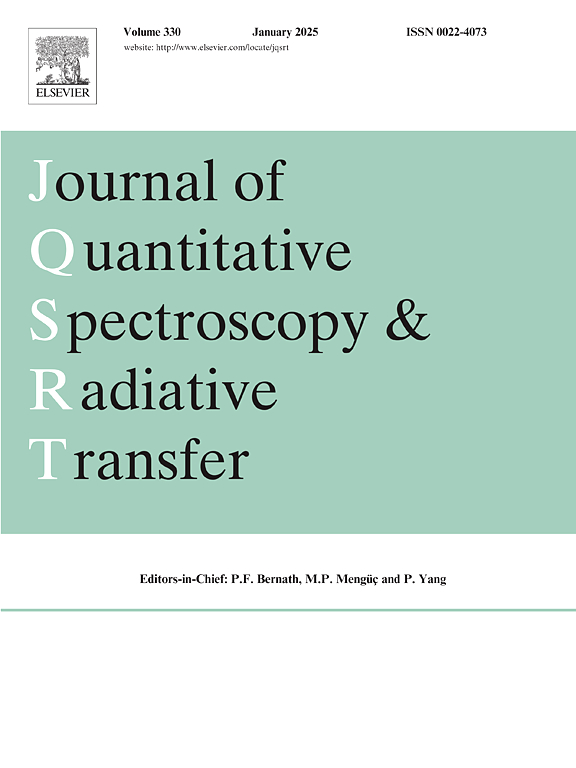使用地面测量和卫星图像量化过渡到LED照明对夜空亮度和颜色的影响
IF 2.3
3区 物理与天体物理
Q2 OPTICS
Journal of Quantitative Spectroscopy & Radiative Transfer
Pub Date : 2025-03-23
DOI:10.1016/j.jqsrt.2025.109450
引用次数: 0
摘要
由于夜间光污染对人类健康、生态系统和休闲活动的有害影响,科学界和公众对夜间光污染越来越感兴趣。最近,世界上许多国家都在用发光二极管(led)改造路灯,以实现智能路灯,同时减少路灯的能源消耗。然而,人们对亮度变化的速度知之甚少,对夜间光谱的新组成就更不了解了。在这项研究中,我们调查了一个主要道路立交夜间光污染的亮度和颜色的变化,测量了从高压钠灯(HPS)黄路灯到白光LED灯过渡前后的情况。我们使用了两台地面光度计,一台是固定光度计(TESS-4C),另一台是移动光度计(LANcube),它们提供了该地点夜间人造光的长期记录。我们还量化了多光谱夜间灯光卫星SDGSAT-1观测到的夜间灯光变化。为了确保无偏置条件,我们使用随机森林模型来区分晴朗和多云的夜晚,以分析TESS-4C的测量结果。这些仪器通过测量不同单位的夜间亮度和捕获不同色带的不同响应光谱来提供全面的分析。我们发现,与之前的HPS灯相比,在立交安装了LED灯后,夜间亮度有所增加。然而,这种增加只是由地面传感器发现的,而不是由卫星发现的。所有传感器都发现了发射光谱向短波长的移动,在量化光谱变化时,红绿比的增加是所有传感器中最一致的。我们讨论了所使用的每种仪器的优点,并探讨了在使用类似LED灯改造路灯的地区,人工夜间照明的预期变化。本文章由计算机程序翻译,如有差异,请以英文原文为准。
Quantifying the impact of the transition to LED lighting on night sky brightness and colour using ground-based measurements and satellite imagery
Nighttime light pollution is gaining significant interest in the scientific community and the public due to its harmful effects on human health, ecosystems, and leisure activities. Recently, many countries worldwide have been retrofitting their streetlights with light emitting diodes (LEDs) to enable smart street lighting while reducing energy use for street lights. However, little is known about the rate of change in brightness and even less about the new composition of the nighttime light spectrum. In this study, we investigated the changes of brightness and colour of light pollution at night in a major road interchange, conducting measurements before and after the transition from high pressure sodium (HPS) yellow street lights to white LED lights. We used two ground-based photometers, one fixed (TESS-4C) and one mobile (LANcube), which provided long-term record of the artificial light at night at this location. We also quantified changes in nighttime lights as observed by the multispectral nighttime lights satellite SDGSAT-1. To ensure non-biased conditions, we used a random forest model to discriminate between clear and cloudy nights for our analysis of the TESS-4C measurements. These instruments offer a comprehensive analysis by measuring night-time brightness in various units and capturing distinct response spectra across different colour bands. We found an increase in nighttime brightness after the interchange was equipped with LED lamps compared to the previous HPS lamps. However, this increase was only identified by the ground sensors and not by the satellite. All sensors identified a shift in the emitted spectrum towards shorter wavelengths, with an increase in the red/green ratio being the most consistent across the sensors in quantifying the spectral change. We discuss the advantages of each instrument used and explore the expected changes in artificial nighttime light for areas that are retrofitting their streetlights with similar LED lamps.
求助全文
通过发布文献求助,成功后即可免费获取论文全文。
去求助
来源期刊
CiteScore
5.30
自引率
21.70%
发文量
273
审稿时长
58 days
期刊介绍:
Papers with the following subject areas are suitable for publication in the Journal of Quantitative Spectroscopy and Radiative Transfer:
- Theoretical and experimental aspects of the spectra of atoms, molecules, ions, and plasmas.
- Spectral lineshape studies including models and computational algorithms.
- Atmospheric spectroscopy.
- Theoretical and experimental aspects of light scattering.
- Application of light scattering in particle characterization and remote sensing.
- Application of light scattering in biological sciences and medicine.
- Radiative transfer in absorbing, emitting, and scattering media.
- Radiative transfer in stochastic media.

 求助内容:
求助内容: 应助结果提醒方式:
应助结果提醒方式:


